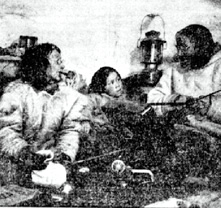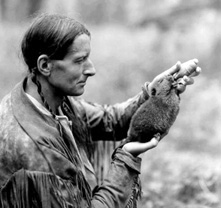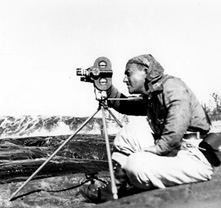Native Peoples in the Cinema
-

La Patrie, 1 September 1946, p.65
Source : Bibliothèque et Archives nationale du Québec
-

Grew Owl’s Little Brother (Gordon Sparling, 1932).
Source : Cinémathèque québécoise, 1995.1367.PH.01
-

Paul Provencher behind the camera.
Source : Cinémathèque québécoise, 2000.0282.PH.04
During the silent period, the cinema was most often content to perpetuate numerous clichés and stereotypes, most of them negative, about native peoples. The work of documentary filmmakers in the years 1930-52 cast a new light on the reality of the country’s First Nations, but fiction films during this same period continued to reinforce stereotypes.
In Hollywood cinema, the “Indians” were most often on the side of the “bad guys”. They were depicted as taciturn and violent people, ready to go on the warpath against the white man for the slightest reason. Indians were positive characters only when they were in the service of white men. Many films thus showed Indians acting as guides, or Indian women heroically sacrificing themselves for the white man they loved.
The Imaginary Indian
The depiction of the First Nations in fiction films was thus not only negative: it was also most often false. Their ways of life were at best an impossible amalgam of details taken from various tribes, or at worst pure fabrication. Hollywood’s primary reference point was by all appearances not the reality of the First Nations but the tradition established by a whole series of entertainments, from Wild West shows (large outdoor circuses with a western theme) to the turn-of-the-century theatrical repertoire. Thus the protagonists of the film Rose-Marie (W.S. Van Dyke, 1936) come upon Indians to the north of Quebec City wearing huge feather headdresses inspired by plains tribes, sculpting immense totem poles vaguely inspired by those found on the Pacific coast, and using in their rituals huge drums straight out of a Broadway stage show.
Nevertheless, some fiction films tried to give a more realistic picture. The Silent Enemy (H.P. Carver, 1930) is a conclusive example. Produced by William Douglas Burden, a Harvard-educated explorer and ethnologist, this film, set in a time before European colonisation, tells the story of a band of Ojibwa beset by the “silent enemy”: hunger. Produced between 1927 and 1929 in northwest Ontario and in the Témiscamingue region of Quebec, The Silent Enemy drew on Burden’s ethnological expertise and involved numerous native persons in its production, mainly as actors.
The lead actor in the film was a colourful character known as Chief Buffalo Child Long Lance, about whom various rumours soon circulated. In fact it appears that Long Lance greatly exaggerated his native origins.
An Englishman named Grey Owl
Long Lance was not only screen figure, however, or even the best known, to have invented picturesque native origins for himself. One of the most famous was Grey Owl, born Archibald Belaney in Hastings, England in 1888. Belaney began his metamorphosis around 1910, when he married a native woman and settled in the forests of northern Ontario. Later, he lived in Quebec, in the area around Cabano. Grey Owl published several popular books, including Man of the Last Frontier (1931), in which he promoted the preservation of nature and animal life. Parks Canada hired him as a naturalist and featured him in a number of documentaries made between 1928 and 1935 by Bill Oliver. The images of Grey Owl in Oliver’s films were widely seen around the world in their sound versions, re-edited by Associated Screen News in Montreal. The image of native peoples found in these films conformed to another stereotype, that of the noble savage in tune with nature.
Indians in Quebec Feature Films
Popular culture in Quebec at the time included another “good Indian”: the character Bill Wabo, created by Claude-Henri Grignon in the novel Un homme et son péché (1933). This character appeared in the radio serial of the same title, as well as in two feature films adapted from Grignon’s work by Québec Productions in 1949 and 1950. Wabo, the sworn enemy of the “bad guy” Séraphin, was a positive character well-loved by the public, a man who cherished his freedom living on the fringes of the white man’s world. He had an aquiline nose and long black hair which fell to his shoulders. Wabo spoke a peculiar French, with very few words and, especially, in incomplete sentences.
Missionary Priests and Explorers
The most respectful images of the true nature of native peoples in Quebec in the 1930-52 period come to us from the ethnographic films made by the various filmmakers found in the province’s religious communities, especially those by Father Louis-Roger Lafleur (1905-1973). An oblate with the Mère-Immaculée order, Father Lafleur used a 16mm Ciné-Kodak to shoot the first ethnographic documentaries of the Algonquin in Abitibi-Témiscamingue. In 1945, he shot Moeurs des Indiens du Québec, Les Indiens du Témiscamingue and Mgr Comtois chez les Têtes-de-Boule. He returned one last time to the Têtes-de-Boule in 1959 to make Les Indiens du Haut-Saint-Maurice.
Father Lafleur hoped his work would rehabilitate the Algonquin in the eyes of white people. At the height of the Duplessis era, his films demonstrated a progressive vision of native peoples and their culture. Some today might say that there is a large share of naïveté in these portraits, that they are too handsome not to be somewhat suspect. But Lafleur succeeded, despite everything, to remind French Canadians in a well-documented and glowing manner that native peoples are also a part of the “family album”, and that they should have a place of honour in it.
The Last Coureur des Bois
At least one non-religious filmmaker worked in a manner similar to that of Father Lafleur: Paul Provencher, known as the “last coureur des bois”. Provencher, a young engineer fresh out of Université Laval, set out in 1929 to explore the boreal forest in search of pulp wood for the Chicago Tribune. He was guided by members of the Montagnais tribe, who were well adapted to the environment and the beneficiaries of age-old knowledge, which Provencher filmed. The colour images of the Montagnais that he took between 1930 and 1940 have priceless ethnographic value. Unlike fiction films of the same period in which native peoples appeared, Provencher’s films were a fair and accurate depiction of the ways and customs of First Nations peoples.